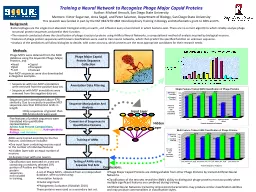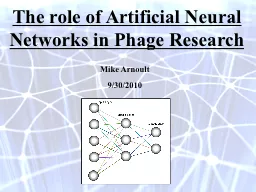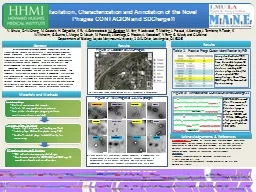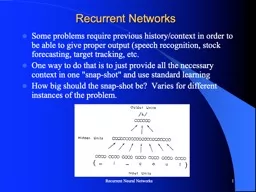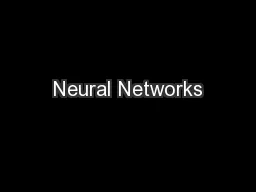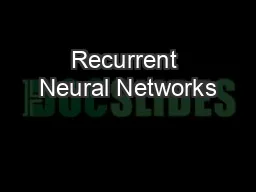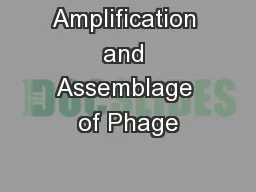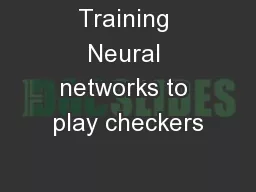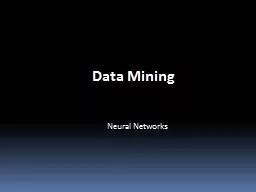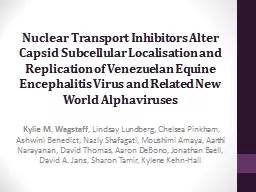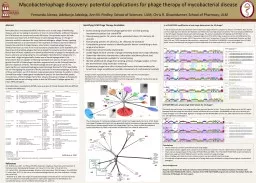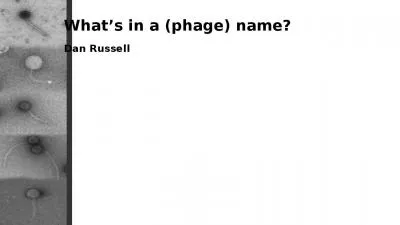PPT-Training a Neural Network to Recognize Phage Major Capsid Proteins
Author : lauren | Published Date : 2022-06-01
Author Michael Arnoult San Diego State University Mentors Victor Seguritan Anca Segall and Peter Salamon Department of Biology San Diego State University Methods
Presentation Embed Code
Download Presentation
Download Presentation The PPT/PDF document "Training a Neural Network to Recognize P..." is the property of its rightful owner. Permission is granted to download and print the materials on this website for personal, non-commercial use only, and to display it on your personal computer provided you do not modify the materials and that you retain all copyright notices contained in the materials. By downloading content from our website, you accept the terms of this agreement.
Training a Neural Network to Recognize Phage Major Capsid Proteins: Transcript
Author Michael Arnoult San Diego State University Mentors Victor Seguritan Anca Segall and Peter Salamon Department of Biology San Diego State University Methods Bacteriophages are the single most abundant biological entity on earth and influence every environment in which bacteria exist There are no current algorithms which reliably analyze phage structural protein sequences and predict their function . Khansa. . Bukhari. Maryum. . Zeb. . History and Definition. Frederick . Twort. (1915) and Felix . d'Herelle. (1917) were the first to recognize bacteriophage.. In the 1930s and after words virologists utilized these viruses as model systems to investigate many aspects of virology. 9/30/2010. The role of Artificial Neural Networks in Phage Research . What is an Artificial Neural Network?. Mathematical and computational model. Motivated by biological neurons. Trained by using features to learn patterns and commonalities. Results of a. . G. oogle . search. Tim . Bryski. – 9/11/12. Exploration trail. Cool. BLOW. YOUR. MIND!. Fun. How do viruses effect us?. Several viruses that effect humans are. Rhinoviruses (common cold). . . Prepare phage for testing. *Create high titer lysate via flooding method.. *Isolate phage DNA and replicate using PCR.. *Send off isolated phage to HHMI facility for . 1. Recurrent Networks. Some problems require previous history/context in order to be able to give proper output (speech recognition, stock forecasting, target tracking, etc.. One way to do that is to just provide all the necessary context in one "snap-shot" and use standard learning. Week 5. Applications. Predict the taste of Coors beer as a function of its chemical composition. What are Artificial Neural Networks? . Artificial Intelligence (AI) Technique. Artificial . Neural Networks. Recurrent Neural Network Cell. Recurrent Neural Networks (unenrolled). LSTMs, Bi-LSTMs, Stacked Bi-LSTMs. Today. Recurrent Neural Network Cell. . . . . Recurrent Neural Network Cell. . . . . Josiah Austin, Julia Tang, Tiffany Nguyen, Michael . Ketteh. , Lynn Zhou, Dr. Mao PhD. The M13 phage is a human-friendly bacteriophage that only infects bacteria cells. 1. . It’s a nanofiber-shaped phage with five different coating proteins wrapped around its DNA (Figure 1b). The M13 phage can be engineered to display the exogenous peptides on its surface. This phage display technique allows us to study the function of short peptides that are derived from the cell’s growth factors, or proteins. Additionally, M13 phage have the ability to self-assemble into organized films that look like which can serve as a matrix for a cell culture. The phage film matrix can give us a better understanding of the role of short peptides in growth factors. The traditional method of making phage films requires the use of a pipette to drop the negatively charged phage solution onto the poly-lysine (Figure 2). However, manually, the results are not replicable and the process is time consuming. In order to make more organized and repeatable phage films we use a programmable slide stainer machine (Carl Zeiss, Inc.) that can dip the slides into a each solution allowing time to dry and giving it the ability to agitate. Resultantly, we built phage films while varying soaking time, phage concentration, and the number of phage layers to determine the best conditions to form well-ordered phage films with the help of slide stainer.. Daniel Boonzaaier. Supervisor – Adiel Ismail. April 2017. Content. Project Overview. Checkers – the board game. Background on Neural Networks. Neural Network applied to Checkers. Requirements. Project Plan. Goals for this Unit. Basic. understanding of Neural Networks and how they work. Ability to use Neural Networks to solve real problems. Understand when neural networks may be most appropriate. Understand the strengths and weaknesses of neural network models. Localisation. and Replication of Venezuelan Equine Encephalitis Virus and Related New World . Alphaviruses. . Kylie M. . Wagstaff. , . Lindsay . Lundberg, . Chelsea . Pinkham, . Ashwini. . Benedict, . of . mycobacterial disease. Fernanda . Alonzo, . Adebanjo. . Adedoja. , . Ann . M. Findley, School of Sciences, . ULM; . Chris . R. . Gissendanner. , School of Pharmacy. , . ULM. . Abstract. Nontuberculous . Learn to build neural network from scratch.. Focus on multi-level feedforward neural networks (multi-level . perceptrons. ). Training large neural networks is one of the most important workload in large scale parallel and distributed systems. Dan Russell. Pauline: 7?!. Happy. Sad. 19. 2. Failure. Success. 19. 41. Star Trek. Star Wars. 9. 17. Batman. Superman. 8. 4. Mulan. Belle. 4. 4. Rapper. Scientist. 37. 43. 3. 5. 6. 10. 0. Mother. Father.
Download Document
Here is the link to download the presentation.
"Training a Neural Network to Recognize Phage Major Capsid Proteins"The content belongs to its owner. You may download and print it for personal use, without modification, and keep all copyright notices. By downloading, you agree to these terms.
Related Documents

